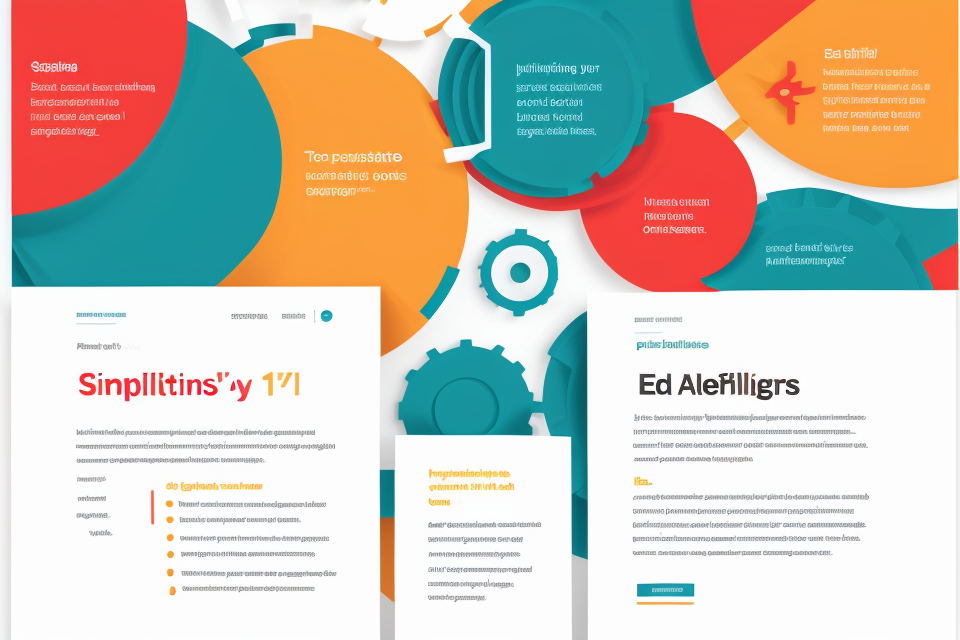
Software development is a complex process that requires careful planning, execution, and optimization. To deliver high-quality software on time and within budget, it is essential to optimize every stage of the development lifecycle. In this article, we will explore some tips and best practices for optimizing software development. From choosing the right tools and technologies to managing project timelines and budgets, we will cover everything you need to know to optimize your software development process. Whether you are a seasoned developer or just starting out, this article will provide you with valuable insights and actionable strategies to help you achieve your software development goals. So, let’s dive in and explore how to optimize software development for maximum efficiency and success.
Understanding Software Optimization
Why is software optimization important?
Software optimization is crucial for a number of reasons, all of which are essential for the success of any software development project. By optimizing software, developers can improve its performance and scalability, reduce costs and resource usage, and enhance user experience and satisfaction.
Improving performance and scalability
Optimizing software is critical for improving its performance and scalability. This means that the software should be able to handle an increasing number of users and transactions without sacrificing speed or efficiency. By optimizing the code, developers can ensure that the software can handle these demands, providing a better user experience and preventing crashes or slowdowns.
Reducing costs and resource usage
Software optimization is also important for reducing costs and resource usage. This is particularly important for businesses that rely on software to operate, as they need to ensure that their software is running efficiently and cost-effectively. By optimizing the code, developers can reduce the amount of resources that the software requires, such as memory or processing power, which can lead to significant cost savings over time.
Enhancing user experience and satisfaction
Finally, optimizing software is essential for enhancing user experience and satisfaction. Users expect software to be fast, responsive, and easy to use, and optimizing the code can help developers deliver on these expectations. By optimizing the software, developers can ensure that it is fast and responsive, even under heavy usage, and that it provides a seamless and intuitive user experience. This can lead to increased user satisfaction and loyalty, which is essential for the long-term success of any software development project.
Types of software optimization
When it comes to optimizing software development, there are several different types of optimization that can be done. Here are some of the most common types of software optimization:
- Performance optimization: This type of optimization focuses on improving the speed and efficiency of the software. This can include reducing the number of operations that are performed, minimizing memory usage, and optimizing algorithms to run faster.
- Resource optimization: Resource optimization involves ensuring that the software is using the appropriate amount of resources such as CPU, memory, and disk space. This can include optimizing the software to use fewer resources, as well as managing resources efficiently to prevent resource starvation.
- Process optimization: Process optimization is concerned with improving the overall development process. This can include streamlining the development workflow, automating repetitive tasks, and improving communication between team members.
- Quality optimization: Quality optimization is focused on improving the overall quality of the software. This can include improving the testing process, implementing code reviews, and incorporating feedback from users to improve the user experience.
Each type of optimization plays a critical role in ensuring that software is developed efficiently and effectively. By understanding the different types of optimization, software developers can prioritize their efforts and ensure that they are focusing on the areas that will have the most significant impact on the overall success of the project.
Best Practices for Software Optimization
1. Use profiling and monitoring tools
When it comes to optimizing software development, one of the most effective strategies is to use profiling and monitoring tools. These tools can help identify bottlenecks and performance issues, analyze resource usage and identify inefficiencies, and monitor and measure system performance over time. By using these tools, developers can gain valuable insights into how their code is performing and where improvements can be made.
One of the key benefits of using profiling and monitoring tools is that they can help identify performance bottlenecks. These bottlenecks can slow down the performance of the software and cause it to run slower than it should. By using profiling tools, developers can identify which parts of the code are causing these bottlenecks and make changes to optimize performance.
Another benefit of using profiling and monitoring tools is that they can help identify resource usage and inefficiencies. This can include identifying which resources are being used most heavily and which resources are being used inefficiently. By identifying these inefficiencies, developers can make changes to optimize resource usage and improve the overall performance of the software.
In addition to identifying performance and resource usage issues, profiling and monitoring tools can also be used to monitor and measure system performance over time. This can help developers identify trends and patterns in system performance and make changes to optimize performance over time.
Overall, using profiling and monitoring tools is a critical best practice for optimizing software development. By gaining insights into how the code is performing and where improvements can be made, developers can make changes to optimize performance and improve the overall quality of the software.
2. Write efficient and maintainable code
Following Best Practices and Coding Standards
To write efficient and maintainable code, it is crucial to follow best practices and coding standards. This includes adhering to guidelines on code formatting, naming conventions, and commenting styles. By following these standards, you can ensure that your code is readable, understandable, and maintainable.
Minimizing Code Complexity and Avoiding Unnecessary Features
One of the keys to writing efficient code is to minimize complexity. This means avoiding unnecessary features and focusing on the core functionality of the software. By keeping the code simple and focused, you can reduce the amount of time and effort required to develop, test, and maintain the software.
Additionally, it is important to avoid unnecessary features that may not contribute to the overall functionality of the software. These features can add complexity to the code and make it more difficult to maintain. By focusing on the essential features, you can ensure that the code is efficient and effective.
Using Appropriate Data Structures and Algorithms
The choice of data structures and algorithms can significantly impact the efficiency of the code. It is important to choose data structures and algorithms that are appropriate for the specific task at hand. This can help to optimize the performance of the software and reduce the amount of memory and processing power required.
For example, if you are working on a software application that requires frequent sorting and searching of large data sets, it may be more efficient to use a specialized data structure such as a binary search tree or a hash table rather than a standard array or linked list.
In addition, using efficient algorithms can help to improve the performance of the software. For example, using a linear algorithm rather than a quadratic algorithm can significantly reduce the amount of processing power required to solve a particular problem.
Overall, by following best practices and coding standards, minimizing code complexity, and using appropriate data structures and algorithms, you can write efficient and maintainable code that is optimized for performance and maintainability.
3. Utilize caching and content delivery networks (CDNs)
One of the most effective ways to optimize software development is by utilizing caching and content delivery networks (CDNs). These techniques can significantly reduce server load and improve response times, resulting in a better user experience. Here’s how caching and CDNs work and why they are essential for software optimization.
Reducing Server Load and Improving Response Times
When a user requests data from a website or application, the server has to process the request and retrieve the necessary data. If the data is not cached, the server has to fetch it from the database or other storage every time, which can be time-consuming and resource-intensive. By caching frequently accessed data, the server can reduce the load and improve response times.
Caching can be implemented at various levels, such as browser caching, server caching, or even database caching. By storing frequently accessed data in cache, it can be retrieved faster, reducing the load on the server and improving the user experience.
Storing Frequently Accessed Data in Cache for Faster Retrieval
Browser caching is a common technique used to cache static content, such as images, stylesheets, and JavaScript files. When a user visits a website, the browser can check if the requested resources are already cached. If they are, the browser can retrieve them from the cache, which reduces the load on the server and improves response times.
Server caching can be used to cache dynamic content, such as database queries or API responses. By caching the results of frequently accessed data, the server can reduce the load on the database and improve response times.
Distributing Static Content through CDNs for Faster Delivery
CDNs are networks of servers that are distributed across different geographic locations. By distributing static content, such as images, videos, and stylesheets, through CDNs, the content can be delivered faster to users. When a user requests content from a website or application, the request is routed to the nearest CDN server, which can serve the content faster than the origin server.
CDNs can also cache static content, which further reduces the load on the origin server and improves response times. By distributing static content through CDNs, the overall performance of the website or application can be improved, resulting in a better user experience.
In conclusion, caching and CDNs are essential techniques for optimizing software development. By reducing server load and improving response times, these techniques can significantly enhance the user experience and ensure that applications and websites run smoothly, even under heavy traffic.
4. Optimize database queries and indexes
Optimizing database queries and indexes is a crucial aspect of software optimization, as it directly affects the performance of applications that rely on databases. In this section, we will discuss some best practices for writing efficient SQL queries and using appropriate indexing strategies to minimize database round-trip times.
Writing Efficient SQL Queries
- Use appropriate join syntax: Joins are a fundamental aspect of SQL queries, and using the appropriate join syntax can significantly improve query performance. For example, using INNER JOIN instead of JOIN can help avoid unnecessary data retrieval.
- Limit the number of columns: Retrieving excessive columns can lead to slower query performance. Limit the number of columns to only those that are necessary for the specific query.
- Avoid subqueries: Subqueries can be slow and resource-intensive, especially when they are nested. If possible, consider using JOIN or other alternatives to achieve the desired result.
Using Appropriate Indexing Strategies
- Identify the most frequently queried columns: Identify the columns that are frequently used in WHERE clauses and index them accordingly. This can significantly improve query performance.
- Use clustered indexing: Clustered indexing involves physically storing data in a specific order, making it faster to retrieve. It is best to use clustered indexing for frequently queried columns.
- Use non-clustered indexing: Non-clustered indexing does not physically store data in a specific order but creates a separate data structure that can be used to improve query performance. It is best to use non-clustered indexing for columns that are frequently queried but not as frequently as the primary key.
Minimizing Database Round-Trip Times
- Minimize the number of round-trips: Each round-trip to the database can significantly slow down query performance. Minimize the number of round-trips by optimizing queries and using appropriate indexing strategies.
- Use caching: Caching can significantly improve query performance by reducing the number of round-trips to the database. Consider caching frequently queried data or results to reduce the load on the database.
- Optimize database server configuration: The configuration of the database server can also affect query performance. Consider optimizing the configuration of the database server to improve query performance.
By following these best practices, you can optimize your software development process and improve the performance of your applications that rely on databases.
5. Leverage cloud computing and containerization
Scaling resources up or down as needed
Cloud computing provides the flexibility to scale resources up or down as needed. This means that businesses can quickly and easily increase or decrease the amount of computing resources they are using based on their current needs. This is particularly useful for businesses that experience fluctuating demand, as they can ensure that they only pay for the resources they need at any given time.
Isolating applications and services for better resource utilization
Containerization is a technology that allows businesses to isolate applications and services from each other, and from the underlying operating system. This helps to ensure that applications and services are run consistently across different environments, and can help to reduce the risk of compatibility issues. It also allows businesses to optimize resource utilization by ensuring that each application or service has access only to the resources it needs.
Taking advantage of cloud-based services and tools
Cloud-based services and tools provide businesses with access to a wide range of functionality, including databases, storage, and networking capabilities. This can help businesses to reduce the cost and complexity of managing their own infrastructure, and can also provide them with access to specialized services and tools that may not be available to them otherwise. Additionally, cloud-based services and tools are often scalable, which means that businesses can easily increase or decrease their usage as needed.
6. Implement continuous integration and delivery (CI/CD)
Automating testing and deployment processes
Continuous Integration (CI) and Continuous Delivery (CD) are essential practices for software development teams. These practices involve automating the testing and deployment processes, which can significantly improve the efficiency and quality of the software development life cycle. By integrating code changes into a shared repository frequently, teams can detect and fix issues early in the development cycle, reducing the risk of introducing bugs and errors into production.
Identifying and fixing issues early in the development cycle
CI/CD helps teams identify and fix issues early in the development cycle. When code changes are automatically built and tested, developers can quickly detect and fix any issues before they become major problems. This helps teams save time and effort by catching issues before they become more complex and difficult to resolve.
Improving collaboration and communication among team members
CI/CD can also improve collaboration and communication among team members. When automated testing and deployment processes are in place, team members can work more closely together, as they can see the results of their work in real-time. This can help reduce misunderstandings and miscommunications, leading to more efficient and effective software development.
Additionally, CI/CD can help ensure that the software development process is more transparent and accountable. By automating testing and deployment processes, teams can more easily track the progress of their work and identify areas where improvements can be made. This can help teams make more informed decisions and continuously improve their processes over time.
FAQs
1. What is software optimization?
Software optimization refers to the process of improving the performance, efficiency, and effectiveness of software development. It involves identifying and eliminating bottlenecks, reducing redundancy, and streamlining processes to increase productivity and deliver high-quality software.
2. Why is software optimization important?
Software optimization is important because it helps teams to deliver software faster, with fewer errors, and at a lower cost. By optimizing the software development process, teams can reduce waste, increase efficiency, and improve the overall quality of the software.
3. What are some tips for optimizing software development?
Some tips for optimizing software development include:
* Use agile methodologies to increase flexibility and responsiveness
* Automate repetitive tasks to reduce errors and save time
* Use continuous integration and continuous delivery (CI/CD) to streamline the software development process
* Prioritize code reviews and testing to ensure high-quality software
* Use modern development tools and technologies to improve productivity
4. How can I improve my software development team’s productivity?
To improve your software development team’s productivity, consider:
* Providing regular training and development opportunities
* Encouraging collaboration and communication
* Implementing best practices and standards
* Streamlining processes and eliminating waste
* Using the right tools and technologies
5. What are some common pitfalls to avoid when optimizing software development?
Some common pitfalls to avoid when optimizing software development include:
* Over-optimizing: Focusing too much on optimization can lead to over-engineering and decreased productivity.
* Ignoring the basics: It’s important to make sure that the basics, such as code quality and testing, are being handled before trying to optimize more advanced aspects of the process.
* Overlooking team dynamics: Optimizing the software development process also involves optimizing the team’s dynamics and communication.
* Not being flexible: Optimization is an ongoing process, and it’s important to be flexible and adapt to changing circumstances.


